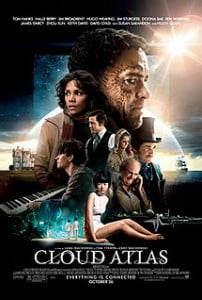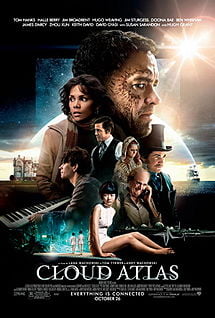 This essay discusses Cloud Atlas (2012), written and directed by Tom Tykwer, Andy Wachowski, and Lana Wachowski, based on the novel by David Mitchell.
This essay discusses Cloud Atlas (2012), written and directed by Tom Tykwer, Andy Wachowski, and Lana Wachowski, based on the novel by David Mitchell.
Specific departures from Cloud Atlas, the book, render this aggressively unconventional movie adaptation more conventional, not less. It is well known that the filmmakers decomposed David Mitchell’s nesting doll structure into a mosaic, skittering back and forth between the story’s six narratives. I haven’t heard anybody observe that they also turned the book inside out.
The film begins and ends with Zachry, the protagonist of the book sixth, and chronologically middle, story, “Sloosha’s Crossin’ an’ Ev’rythin’ After,” narrating his tale as he does in the original. Notice the difference this makes. The main character in each section of the book turns up in a narrative in the next section, allowing interplay among them. There are persuasive arguments that Luisa Rey, of the third narrative, is the only main character who is fictional in the universe of the book. The filmmakers have achieved that prized Hollywood quality, “closure,” by circling the story on itself, but at the cost of suggesting that the whole movie is Zachry’s campfire story—one of the few interpretations the book doesn’t allow.
Whereas the book leaves many possibilities open, wrapping “Sloosha’s Crossin’” around the rest of the movie closes some possibilities off. So does another change made for the screen. The strongest of the book’s six narratives is “An Orison of Sonmi-451,” the story set in Nea So Copros, the 22nd-century “corpocratic” North Korea. The movie’s addition of a gratuitous love story and several explosions harms this episode, as does the omission of Sonmi-451’s final revelation, when she tells her interrogator that the revolutionary movement in which she’s become embroiled was fabricated by the corpocracy to co-opt dissent—and that she has known this all along. Whether or not the reader believes her, they have to reevaluate how they interpret her story and, indeed, the entire book. There’s no such inversion in the movie.
Are the filmmakers wrong to make these simplifications? Not really. But their compromises ought to be observed for what they are.
